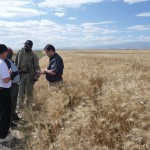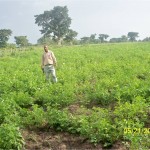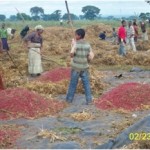The initial major component of MAI’s plan in Ethiopia was to introduce dry farming and drought-resistant crops to the local people. These crops included black alfalfa, wheat, barley, and other forage plants.
Dry farming is not new to the western United States. Dry farm crops have been planted in Washington, Oregon, Utah, Idaho, Wyoming, Montana, North Dakota, and other states for over a hundred years. But, the idea of growing crops in the dry season in Ethiopia was new and created quite a bit of skepticism.
School Property in Kersa Illala
In April of 2008, Paul Morrell decided to test Evan Maxfield’s theory that crops could be grown in the Ethiopian dry season. He began by leasing two properties in Kersa Illala. One property was leased from a local school. This property was 2.47 hectares, or about 25 acres, of land wrapped in a U-shape around a public school. Income derived from this property directly supports the school. The second property was leased from the government. This five acre property, in the middle of the community, is part of the Farmers Training Cooperative, or FTC, and is designated for the government agricultural extension workers to come in and to teach the local farmers better techniques and methods. An orchard was established on this property, but it was the school property that would be used to test dry farming.
June 2008 Planting
The school property in Kersa Illala was acquired during the wet season. In order to utilize the land to its full extent, farm crops were planted in June of 2008. Among the planted crops were orchard grass, tall fescue grass, buffalo grass, perennial rye grass, meadow brome grass, three alfalfa varieties, barley, and wheat.
Soy beans were also planted during the wet season. Legumes, like soy beans, put nitrogen into the soil, while grains, like wheat and barley, consume nitrogen. Rotating these crops helps to keep the soil healthy. Soy beans also have a relatively short growth cycle, they mature quickly, and they were able to be harvested in September. This gave the staff time to prepare the soil for planting in October when the dry season began.
October 2008 Planting
The real test of this farm would come as the dry season rolled in. Varieties of wheat, safflower, and barely were planted at the end of the wet season, in October of 2008. When everyone else in the country was harvesting, threshing, bagging, and winding up the planting season, planting began in earnest on the school property.
Kersa Alfalfa October 2008
The staff at the school property was mandated to use only technologies that were available to local farmers to be sure that the test, if successful, could be duplicated by anyone in the area. Local Ethiopian farmers were hired to come in with their plows to plow, sow, thresh, and harvest using exactly the same methods they normally used in their own farming.
This property was planted and harvested by traditional Ethiopian practices, sowed by hand and plowed by oxen. A tractor was hired at one time, as well, to do some cultivation. But, everything on the farm was done with minimal technological input in order to prove that these dry land crops could grow under any circumstances.
The local farmers were happy to have jobs, during a time of the year when they are usually out of work, but they all were convinced that it was a waste of time and money to plant in October. Abera Chala, hired to be the project manager, didn’t believe that the project was possible either, but he was very conscientious of executing the instructions that were given to him. In December, when the crop was nice and green, MAI told them that a harvest certainly would come, but the locals still laughed and shook their heads.
But, opinions soon changed. By January most of the Rift Valley, over 1,000 miles long, was bare and without crops. But, there was a little oasis, a 25 acre patch of green, in the middle of Kersa Illala. The crops planted in October were mature and had grown remarkably well. The crops were ripe, tall, and healthy and nearing full maturity. Safflower, usually 30-40 inches tall in the United States, was over 72 inches tall in Kersa Illala. It was the exact same seed, but the rich soil of Ethiopia provided an environment well suited to grow thriving crops, and the seeds received more rain than they needed to grow to maturity.
Seeing the crops for themselves, the local people were astonished and thrilled that the first test of dry farming in Ethiopia had been a success; Abera now believed in the project. The dry land wheat may not have been as high-quality as United States crops, as no fertilizer was used, but considering the minimal inputs used in their growth the quality was adequate.
January 2009 Harvest and Open House Event
The first harvest of the school property was in January of 2009. The first test of dry farming in Ethiopia was a success. Together Paul Morrell, founder of MAI, his American team, and the Village of Hope partners had proved that dry farming was a practical option in Ethiopia. They hoped that this technology could be used to improve the economy of the country, and, in so doing, give hope to the people. The progress made to date is extremely promising and is erasing some of the doubt that was evident when the project was first introduced. Morrell Agro Industries is making history in Ethiopia.
On January 31, 2009, MAI held an open house event in Kersa Illala to celebrate and to give people awareness of the successful harvest of the first dry farm in Ethiopia. Paul hired a large advertising company to organize and promote the open house. A big tent was pitched on the school property and fancy decorations and live music added to the festive atmosphere of the event. Paul paid wages and expenses for media staff from the United States and all over Ethiopia to come see the farm’s results. Newspaper reporters, government officials, university professors, and businessmen from all over the country were invited, and it was broadcast on national television stations. Approximately 4,000 people, half of them local, were in attendance. People were able to tour the dry farm and see a vision becoming a reality.
Visitors to the school property were taken on tours of the dry farmed fields, where they could see mature wheat, barley, and safflower approaching harvest. They were surprised that what Evan Maxfield and Paul Morrell had said could be done in Ethiopia had in fact been done. Farmers visiting the field were seen taking seeds off of the stocks, and rubbing them in their hands, comparing their size, weight, and consistency, and they concluded that they were better than the seeds typically seen in Ethiopia. Ethiopian seed typically produced one stock each and 30 seeds per stock, while the American seeds were producing six stocks each and 50 seeds per stock. The quality and volume of the seeds produced on the school property was an unexpected success.
Paul Morrell made the observation during the event that, “Today is the beginning of the end of famine in Ethiopia.” The dry farming approach is a gift to the people of Ethiopia and will hopefully prove to them that they can farm year-round and become a more prosperous people. “Today is the end of the poverty that grinds the hopes and dreams out of the people of Ethiopia.” -Paul Morrell
Government Response
The huge turnout and publicity of the January open house event drew the Ethiopian federal government’s attention. They became excited about the possibilities of a dry season crop, and Paul and his staff were invited to come in and to help them develop this technology. Paul began meeting with various government agencies to determine the next step in creating a business in Ethiopia. The country is run by a socialist government, and the government believes it is their responsibility to be involved in every business and in every aspect of their people’s lives. It creates a difficult environment to operate a business, but Paul believed in what he was trying to do and set out to accomplish it.
Farming and Harvesting Methods
As part of the dry farm initiative, all of the crops were planted by means available to the local people, to insure that the project could be replicated in any condition. The farms were planted in rows made with hoes. Seeds were sown and broadcasted by hand. Oxen and plows drive over the area a second time to cover up the seed.
Local people were hired to work the farm. After the harvest, safflower was threshed by hand, to separate the grain seeds from the plants. The wheat was cut, tied in bundles, and stacked in mounds. In the United States, grain is threshed with a combine, but in Ethiopia bundles are staked in large circles a foot deep. A team of oxen are then run around in circles while a worker with a pitch fork mixes the grain up. The oxen trample the grain seed and trample it out of the heads, and the chaff gets tossed out for straw to be used as animal feed.
The rest of the grain is put in pans and is sifted and thrown into the air so that the light material blows away. The actual grain is left over and is put in sacks for later use to make flour and bread. It’s not the most sanitary way of doing things, but it gets the job done.
MAI has now planted garden crops on the school property in Kersa Illala. Mekonen Geteneh was directed to fill the space with crops, and he has done very well doing so. Potatoes and onions, which are Ethiopian crops, are currently growing there, and it is expected that they will produce a good crop. This year, MAI will get three crops from the property.
Paul Morrell said, “When Evan went over there two years ago, they were doing one crop a year. Here… we don’t allow them to use any technology the guy next door doesn’t have. We plow these fields by ox. We plant by hand. We harvest by hand… Evan and Mekonen together are getting three crops a year off of rain-fed ground. And, it’s really taking off.”
People in Ethiopia are beginning to see the vision that Morrell Agro Industries has for Ethiopia. Many of the local people planted potatoes this year. This is not a new technology for them, but watching MAI have success has lead to the local people believing that they can have success, as well.
One of the main reasons that the Ethiopian people have not planted these crops in the past is that they have had difficulty keeping their neighbors animals off of their fields. One person alone can’t protect their fields. But, they are learning that if a group of people plant their fields and then work together, they can protect their crops much easier. They are also used to being idle for eight months of the year, but this is changing.
The local people have always known that they are able to grow potatoes on their land. They have just never experimented growing their crops in the fourth quarter, or dry season, of the year. It was just never considered. But, this was the first thing that Evan Maxfield demonstrated to the people there, that it was possible to grow dry farm wheat in the fourth quarter. He also successfully grew Ethiopian chic pea in the fourth quarter of that first year he was working in the country.
In Kersa Illala, hundreds of people have planted personal gardens in their little compounds this year, which they haven’t done in other years. Many people in Ethiopia fear that there will be a countrywide famine in the next few months. Paul said, “But, at least in this community, there’s not going to be any famine. Because, they’ve all followed the lead that Evan has established. They followed the lead that Fayisa and the Foresight Fathers have established. And, in this community, he’s changing the culture. He’s changing the way they do business.”
“In that community, they are now aiming to produce two crops each year, while Evan and Mekonen are demonstrating that three crops is a possibility. It’s remarkable.”
The Fall 2010 harvest on the School Farm near Kersa Illala yielded 28 quintals of a local wheat variety, 32 quintals of Jefferson wheat, and 11 quintals of Walker barley.
During the spring season of 2011, 2.25 hectares of potatoes and 2 hectares of haricot beans were planted on the school farm near Kersa Illala. In April, 0.5 hectares of potatoes were also planted on the FTC. There was enough rain for good plant growth, and both crops grew beautifully.
As of September 2011, the FTC and School Farm potato plants are at the harvesting stage. The 2.25 hectares on the school farm were planted and 0.5 hectares on the FTC were planted. Staff working the farms estimate a yield of 200 quintals per hectare.
2011 School Farm Wheat Production Report
From the School Farm, 81 quintals of Jefferson wheat was harvested from 4.5 hectares. The combine measurer showed an average of 18 quintals per hectare as the wheat was being harvested. This wasn’t quite as according to plan, as the land was covered for two years by alfalfa plants. The alfalfa roots were very long and it was very difficult to plow the compacted soil. The land will be good this year, though. If the wheat is sold at 750 birr/quintal, then it can bring in a total of 60,750 birr that can be used for next year’s seed.
2011 FTC and School Farm Horticulture Production Report
On the FTC Farm, 39 quintals of potatoes were harvested from 0.5 hectares of land.
On the School Farm, 295.3 quintals of potatoes were harvested from 2.25 hectares of land, and 20.33 quintals of haricot beans were harvested from 2 hectares of land.
| Crop Type | Cultivated Area | Yield/Hectare | Total yield | |
| FTC Farm | Potato | 0.5 | 78 qt | 39 qt |
| School Farm | Potato | 2.25 | 131.24 qt | 295.3 qt |
| School Farm | Haricot Bean | 2 | 10.17 qt | 20.33 |




